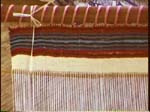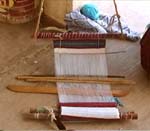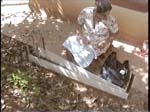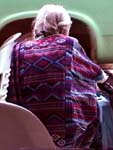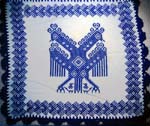The loom preparation takes a while; this requires preparing the thread, stringing the loom, and then the actual weaving process. It is always amazing to see the weaving unfold. In Ojitlan, various women do the work in stages, which speeds up the process of preparation. Every design for the huipil is memorized and then woven or embroidered. Each piece has a distinct character.
Some men from villages surrounding the town wear the traditional white muslin men’s wear. As in many other towns, the younger women will not wear the traditional huipil except on the occasion of a festival. While I was there in the collective, a mother came to buy a huipil so that her daughter would have one for the upcoming festival. On the far right bottom, there is a tortilla cloth with the traditional double-headed bird. There is much speculation about the origins of these double-headed designs. Some say it was the influence of the Spanish royal crest. However, I don’t buy it. Indigenous peoples of Mexico are definitely capable of their own creative processes. There are numerous examples of two-headed animals all over Mexico; they generally represent the two sides of human personality, or good and evil. I will leave it to the anthropologists to sort out the details. |


